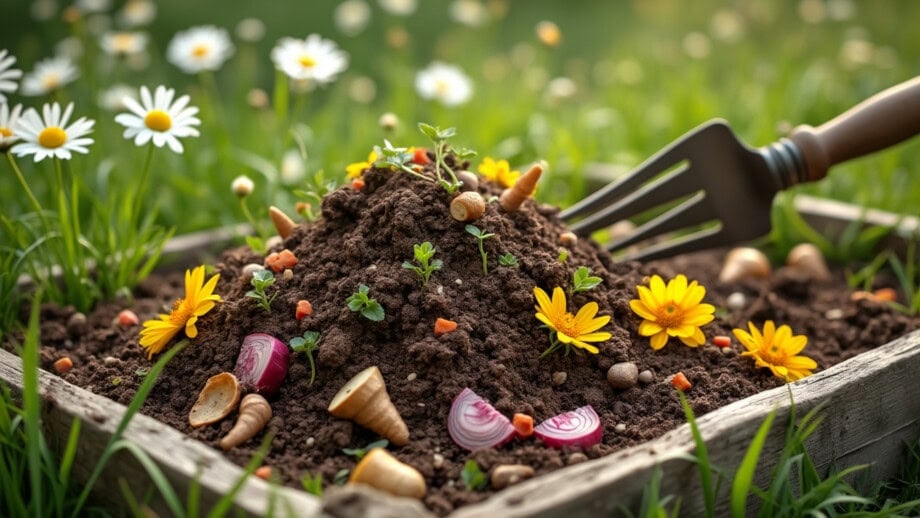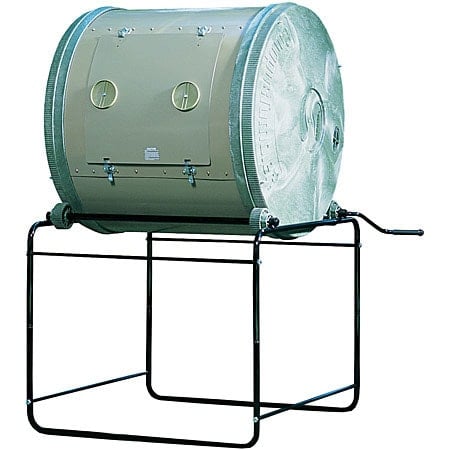Maintenance
Time spent maintaining a compost pile depends on your type of system. More work doesn’t necessarily mean higher temperatures and faster results. Here’s how to do less and get more.


Best product
for Mixing the Pile
Aerator (ICA-36)
An easy and effective way to mix and add oxygen to the pile without heavy lifting.
$29.95Learn moreTurning the Pile
Hot piles require aeration because the micro-organisms use up the oxygen in their close quarters fairly quickly. Cool piles also benefit from occasional turning, which will interrupt any anaerobic processes that may be getting under way in the oxygen-deprived depths of the pile. Any pile that has gone anaerobic or started producing ammonia should be turned immediately. You won’t have to guess whether one of these problems has occurred; the smells will tip you off.
While turning remains the time-honored method of aerating a compost pile, compost aerators reduce or even eliminate the need for that laborious undertaking. There’s more on these under Tools for Dealing with the Pile. Even a length of rebar can be pressed into service.
At Planet Natural we have everything you need for turning kitchen scraps — including meat, bones and dairy — into nutrient rich soil supplements without the usual mess and odors, including attractive pails for collecting your kitchen throwaways.
Turning refers, of course, to mixing a pile, usually with a pitchfork. Just how this is done, and how frequently, depends on your method. A wire bin can be lifted up and set to one side; the pile can then be forked back into it. In some multi-bin systems, when one bin is emptied, the contents of the next are forked into it. Some composters pull everything out of a bin, then toss it back in bit by bit, incorporating new material as they go.
Turning accomplishes two primary purposes: it aerates a pile and it moves material from the relatively cool, inactive periphery to the active center.
A compost aerator lifts material from the bottom of the pile up to the top. That material, of course, gets lots of oxygen, and the process opens up pathways for air and “fluffs” the whole pile to some degree. What it doesn’t do is move feedstock at the edge into the center.
Jim McNelly’s method, described in “Mixing it Up: Hot, Hot, Hot,” needs virtually no maintenance. This pile is built on a grate or openwork pile of sticks and stones and made of ingredients mixed before they’re put in the bin which have been inoculated with mature, active compost. It can be aerated simply with a piece of half-inch rebar. He recommends making holes three to six inches apart that reach all the way through the heap. Such a pile, he says, will stay hot for weeks without turning.

PRE & NATURAL
Compost Starter
Includes the microbes needed to speed up the decomposition of raw organic materials.
$9.95Learn moreSpeed up the decomposition process with Dr. Earth® Compost Starter. It does a thorough job digesting organic material and is suitable for composting leaves, straw, manures, grass clippings, food scraps and other raw products. Infused with beneficial soil microbes and organic nutrients to ensure that all materials are digested to the fullest.
When and How Often?
There’s no absolutely hard and fast rule for when to aerate, because it depends on how wet the pile was to begin with and how quickly it dries out, which depends at least in part on how humid it happens to be in your back yard not only usually, but this week. The rule of thumb for an active, hot pile is every three days until it stops heating up.
Some over-enthusiastic composters rush out after a day and turn the pile. This is a bit too much of a good thing. Turning too often (every day) disrupts the formation of the fungi and actinomycetes that do much of the composting work and may prevent the pile from heating up completely. For the fastest, most efficient decomposition, a pile should be left essentially alone to “cook” until it starts to cool. Then it should be aerated at once and left again. (“Essentially” means that it’s okay to add small batches of stuff to the center of the pile as described under adding new material, below.)
To get a reading of how the pile is doing, wait at least two days after assembling it, then pull away some of the surface material. Six inches down, the pile should be noticeably warm if not downright hot. Check the pile each day, covering the hole after each test. When the material is clearly cooling down, it’s time to turn it.
A compost thermometer thrust into the center of a pile makes it even easier to figure out what’s going on in there. It can also give startling evidence of how hot a hot pile gets. A good, hot pile will reach at least 130°F (54°C) and stay there for two to four days. When the temperature drops back down to about 100°, turn the pile — and watch the temperature soar.

Adding New Material
Most instructions for how to compost recommend batch systems in which you build a pile and then add no new material to it until it has finished heating up and cooling down. The implication is that only batch piles are hot piles because new material will cool the pile down and will be behind the stuff that’s already cooking.
A few experts, however, point out that once a pile is truly up and running, it can easily absorb new material without necessarily being slowed down. Kitchen garbage, especially, which tends to be soft and fairly high in nitrogen, can be dug into the center of a hot pile where it will disappear within days.
Such additions, if made deep enough in the pile, can reduce the need for turning. Turning, after all, is necessary primarily to aerate the pile and digging new material into it can accomplish this in part. Don’t expect additions to entirely replace turning. Only turning will re-aerate the entire pile, unless you have managed to find a way to continuously aerate it.

FREE SHIPPING!
Dueling (25 gal. each)
Makes two batches so the finished product is never more than a few days away.
$159.95Learn moreWhen the garden season is crankin’, you want to transform garden waste into premium organic matter — now. The CompostWizard Dueling Tumbler makes it happen. This small-batch workhorse keeps two separate bins going so the finished product is never more than a few days away.
Large quantities of new material can also be incorporated into a working pile when it is turned. The most thorough mixing will be accomplished on a tarp outside the bin, but interspersing thin layers of new and old material will also mix them sufficiently. Fork six inches or so of the old pile into its new bin, then add several inches of new material, and continue until the bin is full. If your active pile was good and hot, it should heat back up again within a day or two.
If you need compost in the shortest possible time, then use a pure batch system, adding nothing to the pile once it’s built. But if you want to compost the maximum amount of material with maximum efficiency, keep adding material to the center of the pile as it cooks and turn the whole heap whenever it starts to cool, incorporating new material as you do.
Curing the Pile
Even when the hot pile has stopped heating up, it still needs to cure for a couple of weeks before it is ready for use. Heat can become such a focus of quick composting that gardeners forget that several important degradation processes go on only at cooler temperatures.
As the heat-loving thermophilic bacteria die off, mesophilic bacteria that thrive at temperatures between 70 and 100°F (21-38°C) re-establish themselves and continue the composting process. Fungi and actinomycetes, which can be suppressed at high thermophilic temperatures, also flourish at this time. Both play important roles in breaking down tough lignin and cellulose, much of which can withstand even the high temperatures of hot composting.
Fungi and actinomycetes are not the only organisms that return to the pile as it cools. Most of the larger organisms — beetles and the precious garden worm — can’t withstand the temperatures in a hot pile, so they migrate elsewhere as the temperature rises. But as its heat moderates, they move back in. These migrations ensure that when the compost is spread, it will contain the full range of organisms that make compost so vital and so valuable. If compost is not left to cure, these macro-organisms do not have time to re-populate the pile.

















